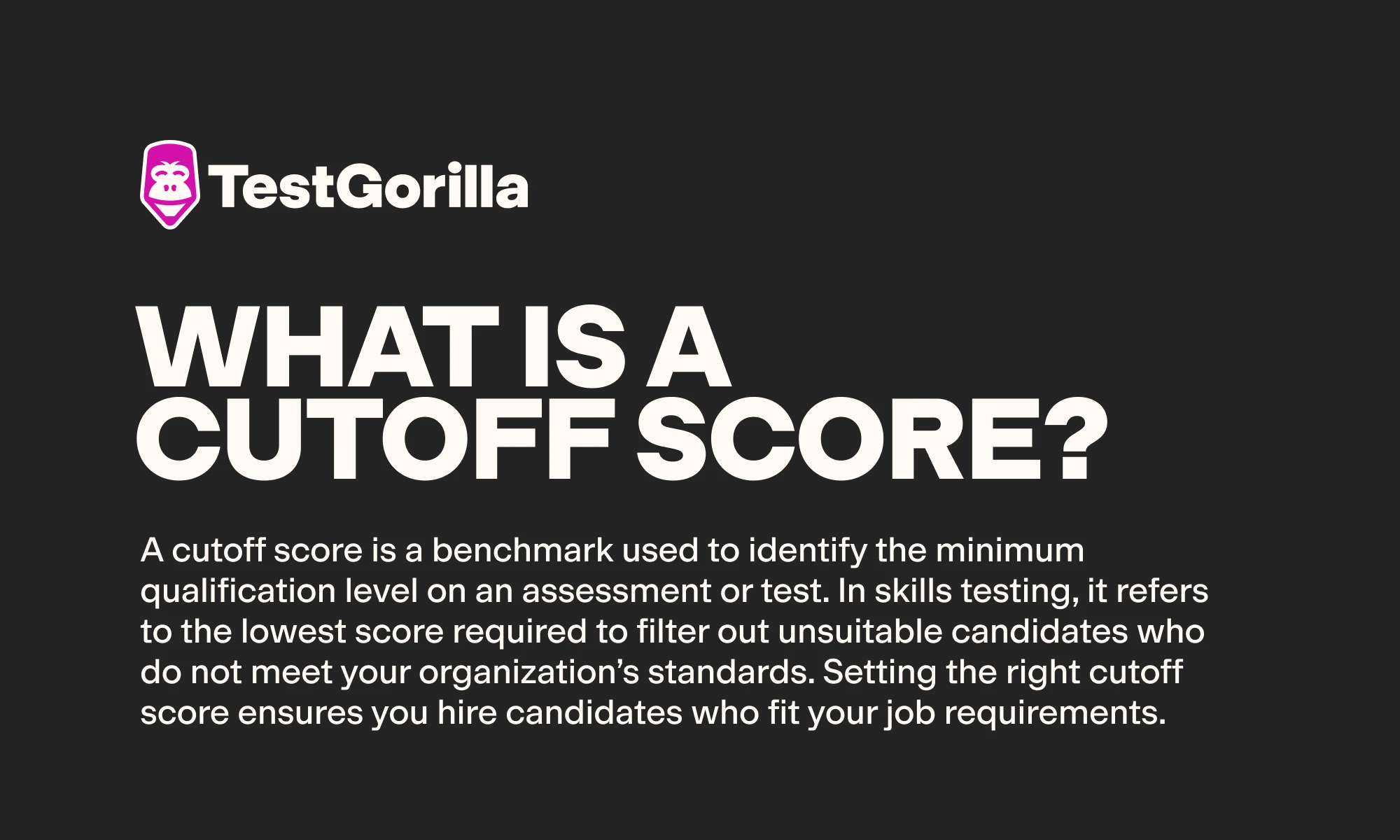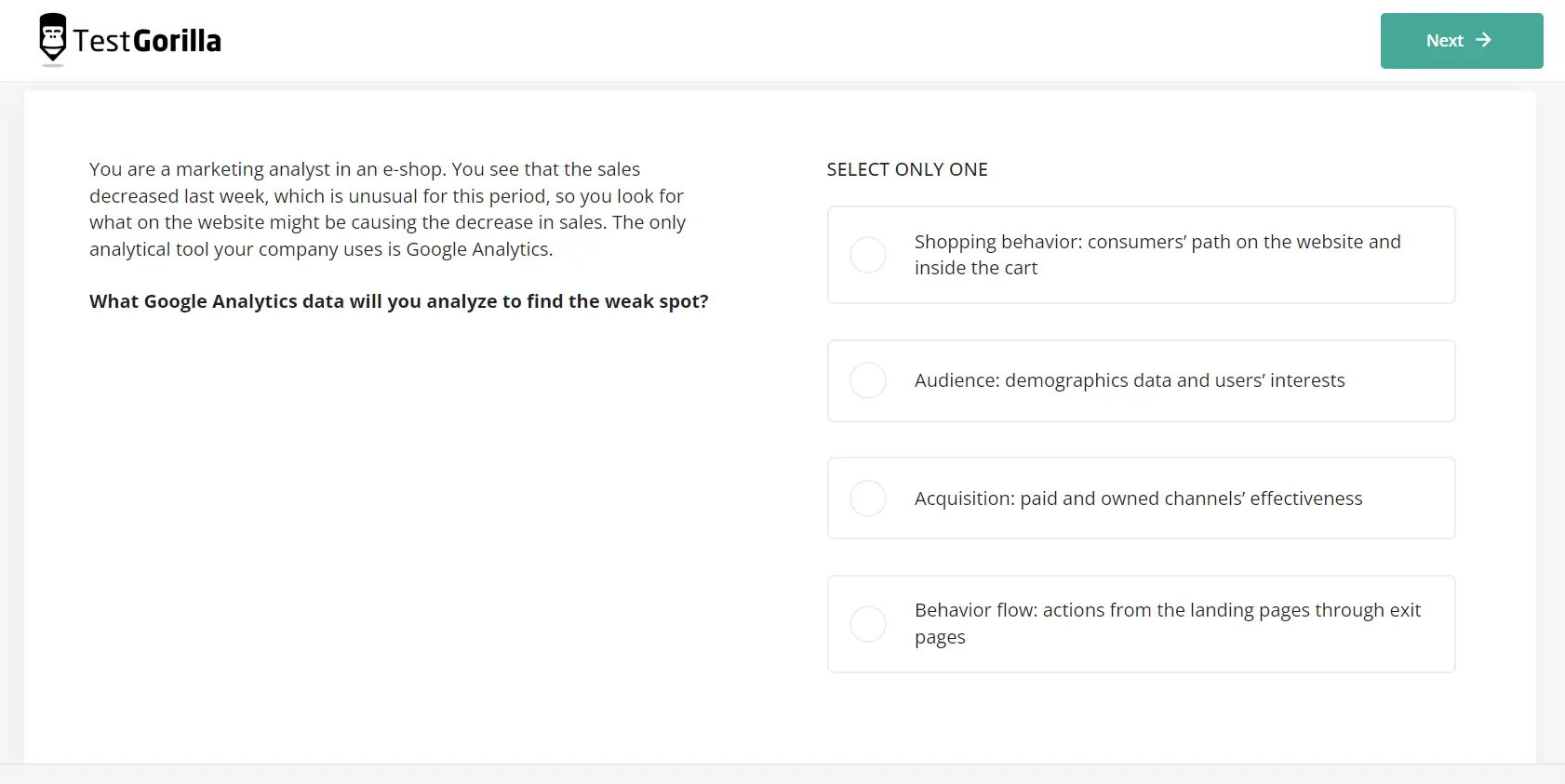What is a cutoff score in skill testing, and how do you set it correctly?
Use talent assessments with adjustable cutoff scores
Without effective cutoff testing, hiring managers often struggle to filter candidates. As a result, you might recruit unqualified applicants or overlook top talent, which wastes time and resources.
Whether you are looking for a business operation manager, DevOps engineer, or marketing specialist, skills tests with appropriate cutoff scores can significantly improve the quality of your hires.
Let’s see what a cutoff score is and what factors you should consider before setting one when recruiting for a vacant position.
What is a cutoff score?
A cutoff score is a benchmark used to identify the minimum qualification level on an assessment or test. In skills testing, it refers to the lowest score required to filter out unsuitable candidates who do not meet your organization’s standards. Setting the right cutoff score ensures you hire candidates who fit your job requirements.
Since different roles require specific skills and abilities, the cutoff scores vary depending on the position.
Why are cut off scores important?
Cutoff scores are important because they help determine your applicants’ skill level or competence. For example, they could show if your candidate has the required proficiency in a language like English, Spanish, or Chinese.
Below are the three main reasons for using cut-off scores.
1. Technical reasons
According to research, 75% of HR professionals recognize skill shortages among job candidates. You need a solid skills test and a good cutoff score to identify applicants with the right abilities.
Filtering out unsuitable candidates early in your recruitment process saves time and puts you ahead of your competitors.
For example, if you’re hiring for a software developer role, you can use TestGorilla’s Python Online test and MySQL test to evaluate the necessary technical skills required for the role.
You set a cut off score to ensure that only test takers scoring at least 80% in each skill progress to the next stage of the hiring process. As a result, you eliminate applicants who lack the required technical proficiency and focus on top talent.
2. Practical reasons
Considering that it takes 44 days to hire somebody, it’s no wonder why many candidates lose interest during this time.
Skill assessments with cutoff scores make the selection process more efficient. They can considerably improve the time to hire and ensure that all your focus is on top candidates.
Let’s be honest: Some candidates look good on paper and in interviews, but they cannot apply the knowledge they claim to have to benefit your company. The possible consequence of this is that you hire the wrong person for the job.
The good news is that 82% of employers who use skills-based hiring manage to find suitable candidates more quickly, and 88% experience fewer mis-hires.
3. Limits employee selection risks
Every interviewer's goal is to hire the right candidate for the role. However, it’s often difficult to determine whether an applicant is a good match based on resumes or interviews alone.
Situations like these create false positives (low-quality candidates who are good on paper) or false negatives (high-quality candidates who look bad on paper).
Skills tests objectively measure candidates’ abilities, reducing the influence of unconscious biases and mental health issues like depressive symptoms.
They standardize the criteria for hiring decisions, ensuring that all candidates receive a fair and consistent evaluation.
Cutoff testing leads to a more diverse talent pool because candidates you would otherwise overlook due to nontraditional educational backgrounds or limited work experience can directly show their skills.
For example, a marketing agency can use skill assessments to evaluate candidates’ creativity, communication, and marketing analytics skills. A candidate from an unrelated industry could lack a traditional marketing background but score highly on the assessments.
The hiring manager moves them to the next stage despite the fact that they do not fit the conventional candidate profile. As a result, the agency strengthens its team with fresh, diverse perspectives.
For more questions from this test, visit the Marketing Analytics test preview.
The best insights on HR and recruitment, delivered to your inbox.
Biweekly updates. No spam. Unsubscribe any time.
Who should set cutoff scores?
Individuals with a firm understanding of the role and the required skill levels should set cutoff scores. At the same time, those aware of labor market conditions and industry competitor trend reports must have a say.
Here’s a list of tips to help you set cut-off scores:
Collaborate with hiring managers and team leaders to identify the core competencies required for the role
Create a skills matrix to rank essential vs. desirable skills
Review performance data of past candidates to understand what scores correlate with successful employees
Research your industry to understand the average skill levels required for similar roles
Conduct a pilot assessment to evaluate the cutoff score’s effectiveness
Verify that your cutoff scores comply with relevant employment and anti-discrimination laws
Monitor how candidates who met the cut off score perform in subsequent stages of the recruitment process or on the job
Get started with TestGorilla’s talent assessments
Our platform has adjustable cutoff scores that enable you to filter candidates and focus only on the best candidates. Expect fewer mis-hires, shorter hiring runs, and improved retention.
What are the types of cutoff scores?
Understanding the cut score meaning can help you determine how to set a reasonable threshold for an available position. Below are the two types of cutoff scores:
1. Performance-related cutoff scores
Performance-related cutoff scores are based on the ideal skill level you want from your future employees.
For example, after reviewing data from current high-performing sales managers, you identify that those who excel in the role consistently score at least 80% on skills tests that evaluate negotiation, customer relationship management, and strategic thinking.
When hiring a new sales manager, you set a cut off score of 80%. If no candidates score better than that, you need to adjust your recruitment strategy to reach better talent.
That involves refining the job description, seeking applicants through alternative channels, or offering a more attractive compensation package.
Higher cutoff scores are associated with roles requiring more advanced performance levels, such as software architects, data scientists, and cybersecurity experts.
2. Group-related cutoff scores
Group-related cutoff scores are based on the performance of candidates in a reference group. This reference group can include current candidates, applicants from the previous year, or current employees.
At TestGorilla, we use group-related cutoff scores by measuring candidates’ performance against norm groups with similar demographics. These norm groups include education level, job function, and seniority.
For example, if an applicant scores 80% on our talent assessment, they performed better than 80% of candidates in the same norm group.
What are the factors to consider when setting cutoff scores?
Larger companies establish reasonable cutoff scores by assessing their employees and using the average score as a benchmark. However, that’s not always possible for smaller companies.
You should consider the following factors before setting cutoff scores for an available position:
1. The number of applicants for the role
You can set a high cutoff score if your company has a large applicant pool for a particular position. For example, a typical corporate job opening attracts 250 candidates.
However, if the applicant pool is small or you have to hire multiple candidates, high cutoff scores restrict the list of qualified applicants, which makes it more difficult to find the right employees for the position.
Still, you must set a minimum baseline score reflecting essential skills, regardless of applicant quantity.
2. Prevailing labor market conditions
Existing labor market conditions largely influence the ideal cutoff score. You can set a high cutoff score if there are many qualified candidates for the role in your industry.
In markets with a shortage of candidates with specific skills, setting an excessively high cutoff score could exclude capable applicants. For example, 71% of organizations struggle to fill cybersecurity roles.
That’s when you should consider a more moderate score, then supplement with additional evaluations or training programs to bridge any skill gaps.
3. The number of vacant positions
Lower cutoff scores can provide more potential employees if you need to fill various positions.
Considering that 75% of employers struggle to find the right talent, you don’t want to exclude candidates who possess the potential skills but need to polish them a little.
You can also establish tiered cut off scores for roles with different responsibilities or seniority levels. Higher scores can apply to more specialized roles, while you can set lower scores for entry-level or generalized positions.
4. Ideal cutoff scores
Based on role requirements, you could have an ideal cutoff score you expect qualified candidates to meet. This ideal cutoff score is a starting point that can change when you consider other factors.
Regularly reviewing performance metrics from previous hires and adjusting the cut off score ensures that it remains aligned with your organization’s changing needs.
5. Whether you should have exceptions
Exceptions are sometimes problematic because they can result in inconsistencies in your recruitment process. That’s why you need to think hard before including exceptions to your cutoff scores.
For example, you can include exceptions to the cut off score if:
You’re hiring for a role with niche skills, like a data science specialist or an AI researcher
Current well-performing employees apply for the job
You have junior candidates showing high learning potential and motivation for upskilling
Candidates exhibit exceptional soft skills like communication, teamwork, and leadership potential
6. Use talent assessment software to determine a cutoff score
Talent assessment software can help you determine a fair and effective cutoff point by measuring candidates against a pool of similar applicants or employees regardless of whether they have a high school or postgraduate education.
TestGorilla’s platform recommends a cutoff score for your assessment, but you can always adjust it to align with your specific hiring needs and preferences, like a promotion point. That enables a flexible and fair approach to talent selection and evaluation.
Improve your hiring process with TestGorilla
Our platform’s adjustable cutoff scores help you filter out candidates effectively, enabling you to focus on the best applicants. This results in fewer mis-hires, shorter time to hire, and better employee retention.
Set better cutoff scores with TestGorilla
Organizations using skills tests and cutoff scores are more likely to hire employees who exceed their performance goals. These employees can help your company grow and increase revenue.
TestGorilla’s comprehensive and expert-approved test library contains various skills tests for which you can set your desired cutoff score. These tests are perfect for evaluating potential employees and ensuring you only hire the best.
Take a product tour to discover how our skills assessments work.
Schedule a live demo to explore all testing possibilities and how you can set the right cutoff score for each assessment.
Sign up for a free forever plan to start hiring better talent today.
Cutoff score FAQs
Need some more help understanding cutoff testing? Read through these two commonly asked questions.
How do cutoff scores work?
Cutoff scores are predefined thresholds used in talent assessments to determine which candidates qualify for further consideration. They work by filtering out applicants who don’t meet the minimum skill level required for a role, ensuring that only the most suitable candidates advance to the next stage. These scores are typically based on job requirements, industry standards, or comparisons with other applicants.
What is an example of a cut-off score?
An example of a cutoff score can be a technical assessment for digital media, where candidates must score at least 75% to qualify for the next hiring stage. This benchmark ensures applicants have the technical skills required for the role, such as programming or data analysis. Those who score below this mark are filtered out.
You've scrolled this far
Why not try TestGorilla for free, and see what happens when you put skills first.

























